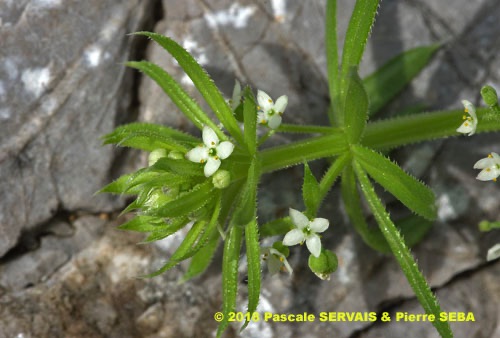
Galium tricornutum Dandy
Fam. : Rubiaceae
© Pascale SERVAIS & Pierre SEBA, 2018. Tilo Botanica: Flore de Tilos et du Dodécanèse / Flora of Tilos and of the Dodecanese
English translation by Brenda Bradbury, Howard Bradbury and Stéphane Léonard
Plante herbacée, hermaphrodite, à tiges rampantes ou grimpantes, peu ou pas ramifiées, quadrangulaires, rugueuses, de 0,6 à 2 mm de diamètre, à poils raides, petits, situés sur les angles, dirigés vers le bas, à 4 ailes très petites.
Feuilles verticillées par 6 à 8, simples, linéaires à lancéolées, entières, sessiles, terminées par une pointe, de 8 à 30 mm de long, de 2 à 6 mm de large, à limbe glabre mais cilié avec des petits poils crochus dirigés vers le bas, avec, sur la face inférieure, 1 nervure à aiguillons crochus.
Fleurs à symétrie radiaire, blanches, de 2,5 à 3 mm de diamètre, réunies par 2 à 5 en cymes bipares de 5 à 7 mm de large, portés par un pédoncule égalant ou plus court que les feuilles sous-jacentes. 2 cymes partant de chaque verticille de feuilles. Corolle à 4 pétales soudés à la base, terminés par un petit mucron. Calice réduit à un bourrelet annulaire. 4 étamines saillantes à filet blanc et anthère jaune. 1 style saillant blanc. Ovaire infère.
Fruits, capsules sphériques, par deux, de 2 à 6 mm de diamètre, vertes, glabres, couvertes de petites verrues aiguës, portées par un pédicelle épais recourbé vers le bas et vers l’intérieur.
___________________________
Plant herbaceous, hermaphrodite. Stems trailing or climbing, little or not branched, quadrangular, rough, from 0.6 to 2 mm in diameter, with stiff, small hairs, located on the angles, directed to the bottom, with 4 very small wings.
Leaves whorled by 6 to 8, simple, linear to lanceolate, entire, sessile, finished by a point, from 8 to 30 mm long, from 2 to 6 mm across, with glabrous blade but ciliate with small hooked hairs directed to the bottom, with, on lower surface, 1 vein with hooked prickles.
Flowers radially symmetrical, white, from 2.5 to 3 mm in diameter, joined together by 2 to 5 in symmetrical cymes from 5 to 7 mm across, carried by a peduncle as long as or shorter than the underlying leaves. 2 cymes proceeding from each whorl of leaves. Corolla with 4 partly fused petals, finished by a small mucron. Calyx reduced to an annular pad. 4 protruding stamens with white filament and yellow anther. 1 white protruding style. Ovary inferior.
Fruits, spherical capsules, in pairs, from 2 to 6 mm in diameter, green, glabrous, covered in small acute warts, carried by a thick pedicel curved to the bottom and towards the inside.
Descripteurs / Identifying features
1
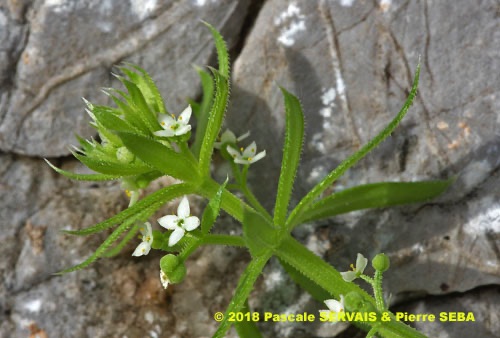
2
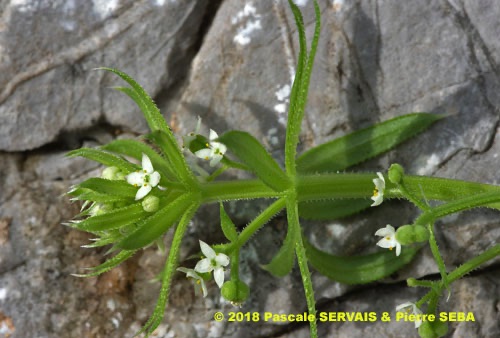
3
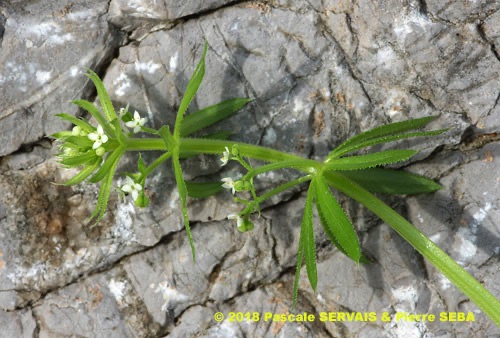
4
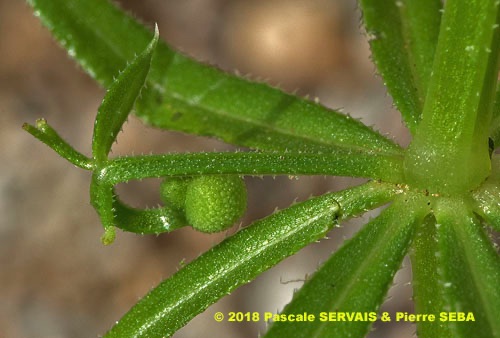
5
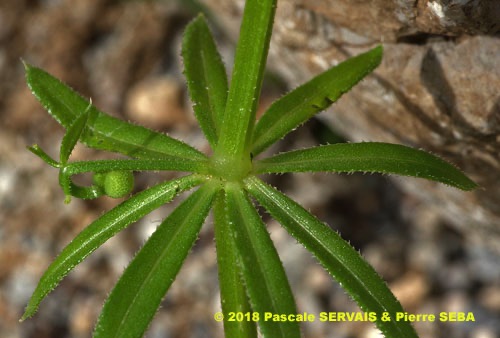
6
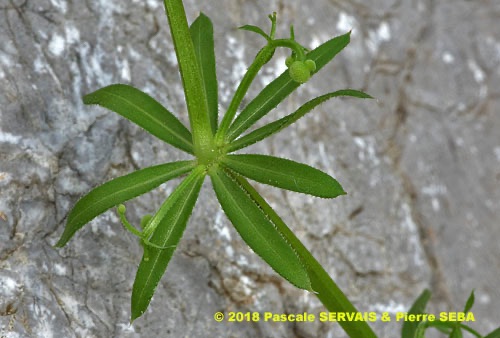
7
Étymologie / Etymology :
Galium : emprunt du grec ancien γάλα, γάλακτος (nom) = le lait,
en référence à la propriété de certaines espèces utilisées pour faire
cailler le lait.
Tricornutum : emprunt du latin tricornutus, -a, -um (adj.)
[ < tres, tria (adj.) = trois + cornu, -us (nom) = la corne ] = qui a trois
cornes, en référence aux fleurs généralement groupées par trois.
Galium : borrowed from Classical Greek γάλα, γάλακτος (noun) = milk,
referring to the property of some species used to curdle milk.
Tricornutum : borrowed from Latin tricornutus, -a, -um (adj)
[ < tres, tria (adj) = three + cornu, -us (noun) = horn ] = with three
horns, referring to the flowers usually grouped by three.
Synonymes / Synonyms :
Galium tricorne Stokes
Galium tricorne var. microcarpum Gren.
Rubia tricornis Baill.
Valantia tricornis Roth
Noms vernaculaires / Common names :
Noms français / French names :
Gaillet à trois cornes — Gaillet à trois pointes.
Nom grec / Greek name :
Κολητσίδα κυρτόκαρπη.
Noms anglais / English names :
Corn cleavers — Roughfruit corn-bedstraw.
Nom allemand / German name :
Dreihörniges Labkraut.
Nom espagnol / Spanish name :
Amor del hortelano con tres flores.
Nom italien / Italian name :
Caglio coriandolino.
Habitat :
Cultures - Chemins.
Cultivated places - Waysides.
Île / Island :
Tilos.
Hauteur / Height range :
De 5 cm à 50 cm.
From 5 cm to 50 cm.
Floraison / Flowering time :
De janvier à juin.
From January to June.
Groupe / Classification :
Dicotylédones.
Dicotyledons.
Pérennité / Lifespan :
Annuelle.
Annual.
Description :
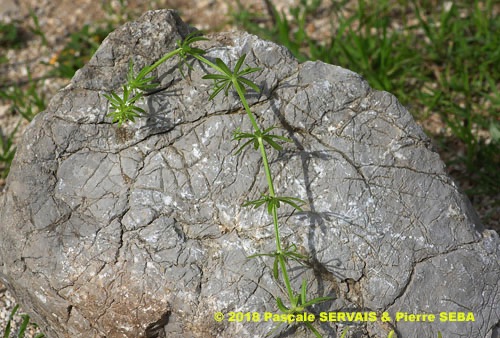
8
Clés dichotomiques et descripteurs distinctifs des 8 espèces / Dichotomous keys and distinctive identifying features of the 8 species
Photo 1 :
Localisation / Location : Tilos, Megalochorio, Plaine d'Erystos
Date : 05/02/2018
GPS : Lat. 36,44437° N / Long. 27,34927° E / Alt. 21 m
Type : Photographie numérique / Digital Photograph (24 mégapixels)
Photo 2 :
Localisation / Location : Tilos, Megalochorio, Plaine d'Erystos
Date : 05/02/2018
GPS : Lat. 36,44437° N / Long. 27,34927° E / Alt. 21 m
Type : Photographie numérique / Digital Photograph (24 mégapixels)
Photo 3 :
Localisation / Location : Tilos, Megalochorio, Plaine d'Erystos
Date : 05/02/2018
GPS : Lat. 36,44437° N / Long. 27,34927° E / Alt. 21 m
Type : Photographie numérique / Digital Photograph (24 mégapixels)
Photo 4 :
Localisation / Location : Tilos, Megalochorio, Plaine d'Erystos
Date : 05/02/2018
GPS : Lat. 36,44437° N / Long. 27,34927° E / Alt. 21 m
Type : Photographie numérique / Digital Photograph (24 mégapixels)
Photo 5 :
Localisation / Location : Tilos, Megalochorio, Plaine d'Erystos
Date : 05/02/2018
GPS : Lat. 36,44437° N / Long. 27,34927° E / Alt. 21 m
Type : Photographie numérique / Digital Photograph (24 mégapixels)
Photo 6 :
Localisation / Location : Tilos, Megalochorio, Plaine d'Erystos
Date : 05/02/2018
GPS : Lat. 36,44437° N / Long. 27,34927° E / Alt. 21 m
Type : Photographie numérique / Digital Photograph (24 mégapixels)
Photo 7 :
Localisation / Location : Tilos, Megalochorio, Plaine d'Erystos
Date : 05/02/2018
GPS : Lat. 36,44437° N / Long. 27,34927° E / Alt. 21 m
Type : Photographie numérique / Digital Photograph (24 mégapixels)
Photo 8 :
Localisation / Location : Tilos, Megalochorio, Plaine d'Erystos
Date : 05/02/2018
GPS : Lat. 36,44437° N / Long. 27,34927° E / Alt. 21 m
Type : Photographie numérique / Digital Photograph (24 mégapixels)

Google Maps
Google Maps
Google Maps
Google Maps
Google Maps
Google Maps
Google Maps
Google Maps